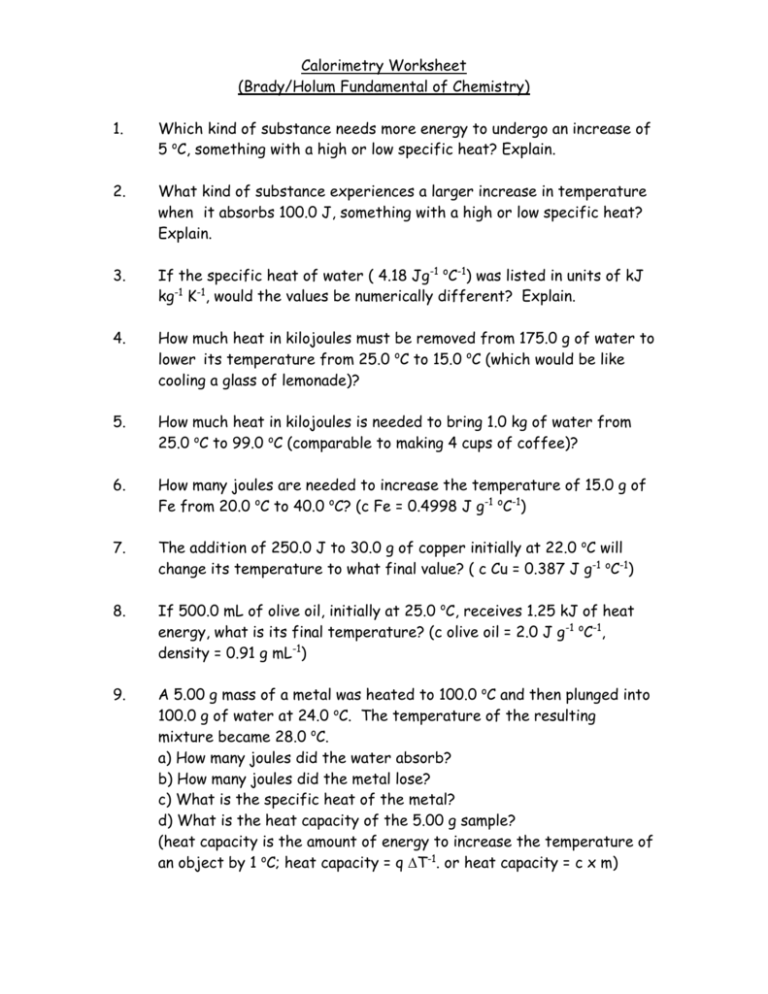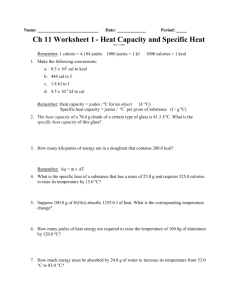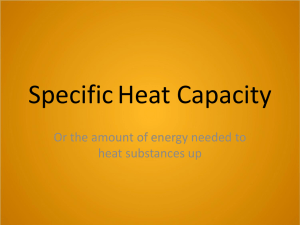Calorimetry Worksheet
advertisement

Calorimetry Worksheet (Brady/Holum Fundamental of Chemistry) 1. Which kind of substance needs more energy to undergo an increase of 5 oC, something with a high or low specific heat? Explain. 2. What kind of substance experiences a larger increase in temperature when it absorbs 100.0 J, something with a high or low specific heat? Explain. 3. If the specific heat of water ( 4.18 Jg-1 oC-1) was listed in units of kJ kg-1 K-1, would the values be numerically different? Explain. 4. How much heat in kilojoules must be removed from 175.0 g of water to lower its temperature from 25.0 oC to 15.0 oC (which would be like cooling a glass of lemonade)? 5. How much heat in kilojoules is needed to bring 1.0 kg of water from 25.0 oC to 99.0 oC (comparable to making 4 cups of coffee)? 6. How many joules are needed to increase the temperature of 15.0 g of Fe from 20.0 oC to 40.0 oC? (c Fe = 0.4998 J g-1 oC-1) 7. The addition of 250.0 J to 30.0 g of copper initially at 22.0 oC will change its temperature to what final value? ( c Cu = 0.387 J g-1 oC-1) 8. If 500.0 mL of olive oil, initially at 25.0 oC, receives 1.25 kJ of heat energy, what is its final temperature? (c olive oil = 2.0 J g-1 oC-1, density = 0.91 g mL-1) 9. A 5.00 g mass of a metal was heated to 100.0 oC and then plunged into 100.0 g of water at 24.0 oC. The temperature of the resulting mixture became 28.0 oC. a) How many joules did the water absorb? b) How many joules did the metal lose? c) What is the specific heat of the metal? d) What is the heat capacity of the 5.00 g sample? (heat capacity is the amount of energy to increase the temperature of an object by 1 oC; heat capacity = q T-1. or heat capacity = c x m) 10. Fat tissue is 85 % fat and 15 % water. The complete breakdown of the fat itself converts it to CO2 and H2O, which releases 9.0 kcal per gram of the fat in the tissue. a) How many kilocalories are released by the loss of 1.0 lbs of fat tissue in a weight reduction program? ( 2.2 lbs = 1.0 kg) b) A person running 8.0 miles hr-1 expends about 5.0 x 102 kcal hr-1 of extra energy. How far does a person have to run to burn off 1.0 lbs of fat tissue by this method alone? 11. Nitric acid reacts with potassium hydroxide as follows HNO3(aq) + KOH(aq) KNO3(aq) + HOH(l) A student places 55.0 mL of 1.3 M nitric acid at 23.5 oC into a coffee cup calorimeter and adds 55.0 mL of 1.3 M potassium hydroxide also at 23.5 oC. After stirring the mixture with a thermometer the temperature of the solution rose to 31.8 oC. Assuming the system is water based, calculate the heat evolved in joules and the heat evolved per mole of acid (kJ mole-1).







